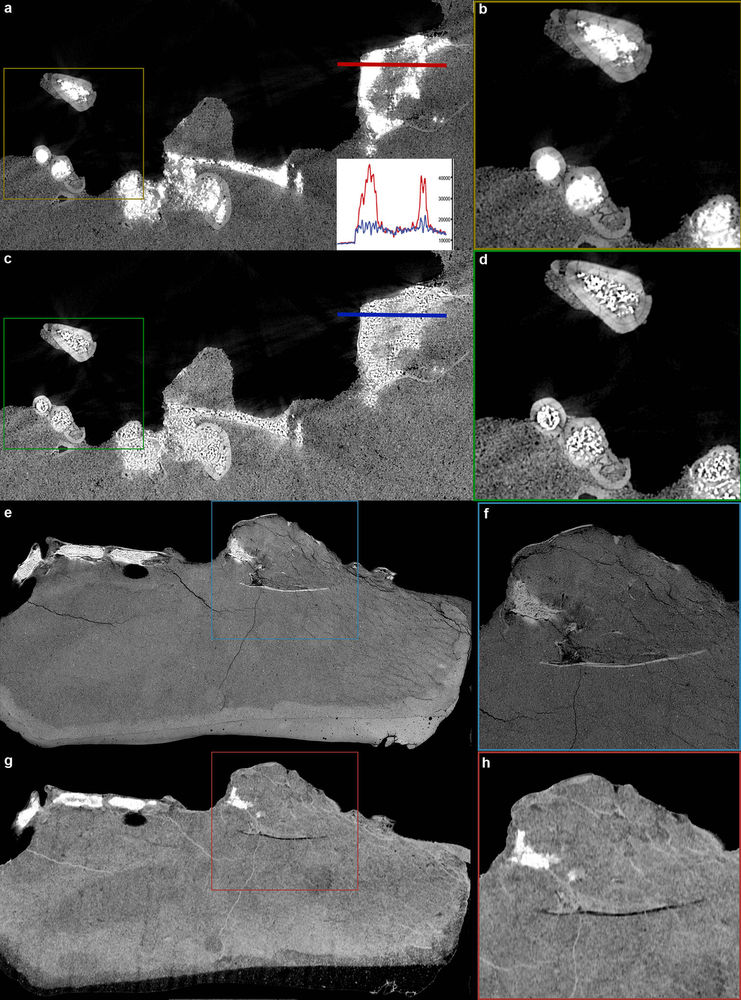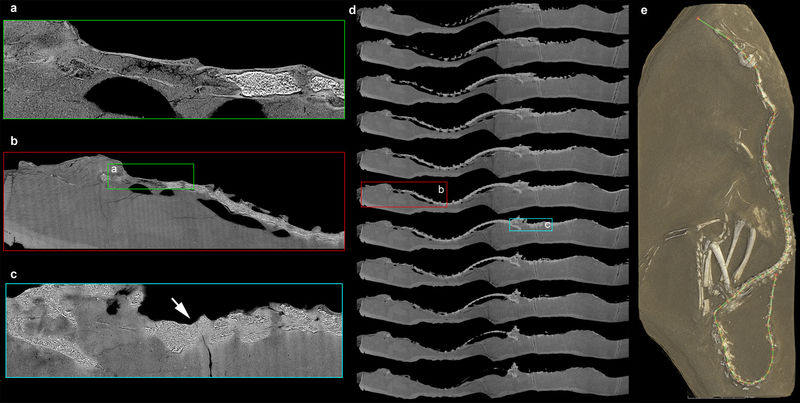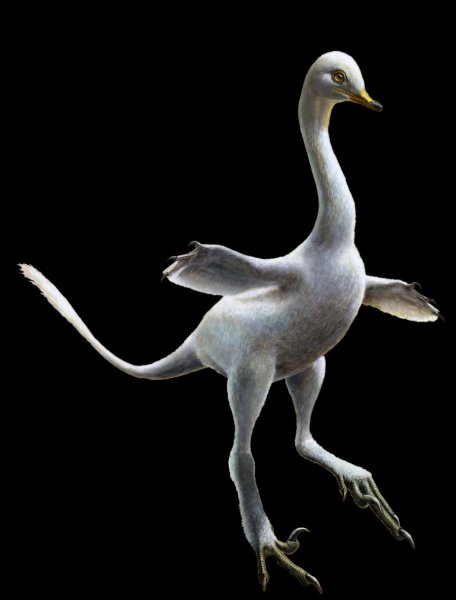@WFS,World Fossil Society,Riffin T Sajeev,Russel T Sajeev
An exceptionally well-preserved dinosaur skeleton from Mongolia unites an unexpected combination of features that defines a new group of semi-aquatic predators related to Velociraptor. Detailed 3D synchrotron analysis allowed an international team of researchers to present the bizarre 75 million-year-old predator, named Halszkaraptor escuilliei, in Nature. The study not only describes a new genus and species of bird-like dinosaur that lived during the Campanian stage of the Cretaceous in Mongolia but also sheds light on an unexpected amphibious lifestyle for raptorial dinosaurs.

a, Virtual section or the original dataset. b, Detail of a. c, Virtual section from the dataset corrected for metallic inclusions. d, Detail of c. Histograms along the blue and red lines demonstrate how metallic inclusions prevent adjusting the contrast to focus on the bone–matrix contact. e, Virtual section along the longitudinal axis of the cranium on dataset corrected for metallic inclusions. f, Detail of e. g, Same virtual section as in e, on data processed with the texture enhancement algorithm. h, Detail of g. In the processed data (g, h), homogenous parts (for example, bone or plaster) appear dark and the sediment reveals features that were barely visible prior to processing (e, f).
Theropods encompass all carnivorous dinosaurs, including the largest land-living predators in the history of life on Earth, such as Tyrannosaurus, and iconic agile hunters like Velociraptor. During 160 million years of the Mesozoic Era, theropods became the dominant predators on all continents, yet never conquered aquatic environments. Although some theropods reportedly incorporated fish in their diet, proposed indications for aquatic locomotion associated with exclusively aquatic lifestyles remain controversial.

a, Detail of anterior end of neck and posterior half of skull that shows continuity of the craniocervical transition. b, Detail of neck and skull that shows continuity between bones and matrix. c, Detail of proximal caudal series that shows the glued crack that crosses both matrix and bone (arrow), which confirms continuity between the sacrum and tail. d, Selected series of slices that show the continuity of bones and matrix along main slab. e, Overview of MPC-D102/109 indicating the curved virtual slice along a polyline (materialized above a 3D rendering) with slices at 5 mm on each side of this line every 1 mm. The line follows the axial column in order to show the continuity of the vertebral series. Scale bar, 70 mm. The renderings are generated using scan data that have been corrected for the absorbing metallic oxide infilling.
A swan-necked and flipper-forelimbed new dinosaur species that combines an unexpected mix of features now demonstrates that some bird-like dinosaurs did adopt a semi-aquatic lifestyle. The fossil, nicknamed “Halszka” for Halszkaraptor escuilliei, was found at Ukhaa Tolgod. This locality in southern Mongolia has been known by palaeontologists for decades and is often targeted by poachers. “Illicit fossil trade presents a great challenge to modern palaeontology and accounts for a dramatic loss of Mongolian scientific heritage,” says Pascal Godefroit of the Royal Belgian Institute of Natural Sciences in Brussels. “Illegally exported from Mongolia, Halszka resided in private collections around the world before it was acquired in 2015 and offered to palaeontologists for study and to prepare its return to Mongolia.”

Reconstruction of Halszkaraptor escuilliei. This small dinosaur was a close relative of Velociraptor, but in both body shape and inferred lifestyle it much closely recalls some waterbirds like modern swans.
Credit: Lukas Panzarin; and Andrea Cau for scientific supervision
Although several important groups of predatory dinosaurs have been discovered in Mongolia, Halszka does not belong to any of them, having a number of strange features that are mostly absent among dinosaurs, but are shared by reptilian and avian groups with aquatic or semiaquatic ecologies. “The first time I examined the specimen, I even questioned whether it was a genuine fossil” says Andrea Cau of the Geological Museum Capellini in Bologna. Although Halszka is unique in many ways, certain parts of the skeleton, including the sickle-shaped “killer claws” on its feet, are shared with well-known dinosaurs such as Velociraptor. “This unexpected mix of traits makes it difficult to place Halszka within traditional classifications,” Cau remarks.

a, Dorsal view. b, Palatal view. p11, 11th premaxillary tooth; m16, 16th maxillary alveolus. c, Semi-transparent left lateral view that shows dentition. d, Left lateral view. af, antorbital fossa; en, external naris; mr, maxillary recess; pms, premaxillo-maxillary suture. e, Semi-transparent right lateral view that shows dentition. f, Right lateral view. en, external naris; nf, neurovascular foramina. Scale bars, 3 mm.
In order to ascertain the integrity of the fossil, the specimen was visualised and reconstructed in three dimensions using synchrotron multi-resolution X-ray microtomography. “This technique is currently the most powerful and sensitive method to image internal details without damaging invaluable fossils. The ESRF has become the worldwide leader for high quality X-ray imaging of such precious specimens,” notes Paul Tafforeau of the ESRF. “We had to mobilise an ESRF team of palaeontologists to study the complete anatomy of Halzka. So far, it’s the specimen for which the greatest number of experiments were made on a single fossil,” adds Tafforeau.
“Our first goal was to demonstrate that this bizarre and unexpected fossil is indeed a genuine animal: multi-resolution scanning confirmed that the skeleton is not a composite assembled from parts of different dinosaurs,” explains Dennis Voeten of the ESRF. “We implemented new methods for the acquisition and optimisation of tomographic scan data, which not only confirmed the integrity of the specimen, but also revealed additional palaeontological information,” Vincent Fernandez of the ESRF clarifies.

a, Premaxillary teeth in labial view. b, Premaxillary teeth in lingual view. c, Maxillary teeth in labial view. d, Maxillary teeth in lingual view. e, Maxillary teeth in basal view. f, Dentary teeth in lingual view. rt, replacement tooth. Scale bars, 1 mm.
The synchrotron was even able to reveal, in astonishing detail, those parts of the skeleton that have remained deep within the rock ever since the dinosaur got buried. “Our analysis demonstrated that numerous teeth, which are not visible externally, are still preserved inside the mouth,” says Vincent Beyrand of the ESRF. “We also identified a neurovascular mesh inside its snout that resembles those of modern crocodiles to a remarkable degree. These aspects suggest that Halszka was an aquatic predator.”
The ESRF data revealed that the fossil represents a new genus and species of amphibious dinosaur that walked on two legs on land, with postural adaptations similar to short-tailed birds (like ducks), but used its flipper-like forelimbs to manoeuvre in water (like penguins and other aquatic birds), relying on its long neck for foraging and ambush hunting.
This new species was named Halszkaraptor escuilliei. Its generic name honours the late palaeontologist Halszka Osmólska. “This important genus is named in recognition of Halszka’s contribution to the study of Mongolian dinosaurs from the Gobi,” comments Rinchen Barsbold of the Mongolian Academy of Sciences. “The specific name refers to François Escuillié and thereby acknowledges his role in the first recognition and in the return of this specimen to Mongolia,” adds Khishigjav Tsogtbaatar of the Institute of Paleontology and Geology in Ulaanbaatar.
Halszkaraptor is not the only strange dinosaur recovered from the Gobi. Several previously described enigmatic Mongolian theropods were closely related to the new species, the study found. United in a new group, named Halszkaraptorinae, “is an unexpected subfamily of dromaeosaurs — the group colloquially known as raptors. This bizarre subfamily appears to have evolved a lifestyle different from all other predatory dinosaurs,” says Philip Currie of the University of Alberta.
“When we look beyond fossil dinosaurs, we find most of Halszkaraptor‘s unusual features among aquatic reptiles and swimming birds,” concludes lead author Andrea Cau. “The peculiar morphology of Halszkaraptor fits best with that of an amphibious predator that was adapted to a combined terrestrial and aquatic ecology: a peculiar lifestyle that was previously unreported in these dinosaurs. Thanks to synchrotron tomography, we now demonstrate that raptorial dinosaurs not only ran and flew, but also swam!”
- Andrea Cau, Vincent Beyrand, Dennis F. A. E. Voeten, Vincent Fernandez, Paul Tafforeau, Koen Stein, Rinchen Barsbold, Khishigjav Tsogtbaatar, Philip J. Currie, Pascal Godefroit. Synchrotron scanning reveals amphibious ecomorphology in a new clade of bird-like dinosaurs. Nature, 2017; DOI: 10.1038/nature24679
- European Synchrotron Radiation Facility. “Synchrotron sheds light on the amphibious lifestyle of a new raptorial dinosaur.” ScienceDaily. ScienceDaily, 6 December 2017. <www.sciencedaily.com/releases/2017/12/171206132218.htm>.
- @WFS,World Fossil Society,Riffin T Sajeev,Russel T Sajeev



 December 7th, 2017
December 7th, 2017  Riffin
Riffin  Posted in
Posted in  Tags:
Tags: 